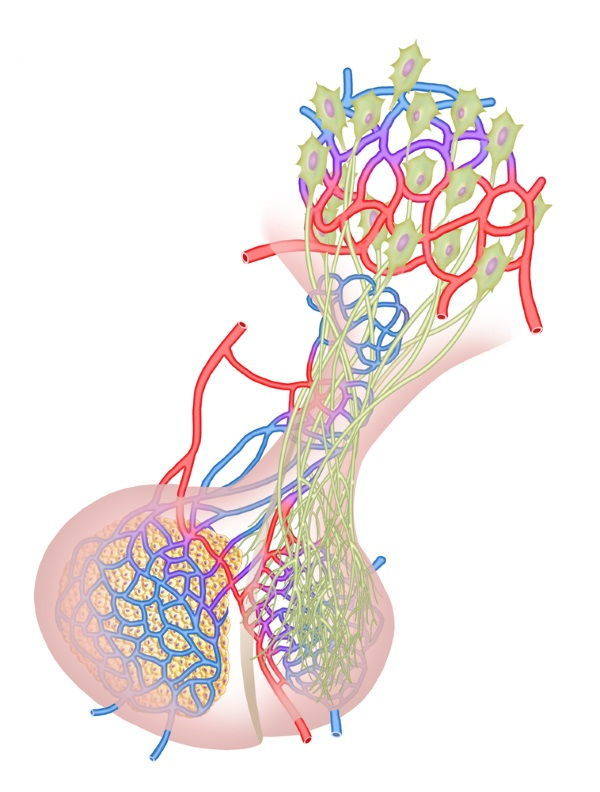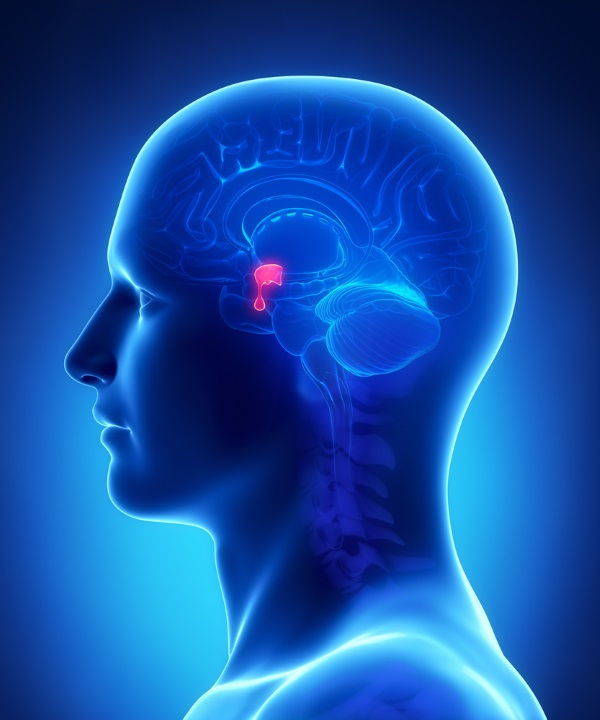The pituitary gland is a small gland located at the base of the brain that performs functions of fundamental importance. It regulates hormone secretion by the other endocrine glands and is involved in numerous vital functions. In case of hyperfunction or hypofunction of this gland, various pathologies can arise, from pituitary adenomas to a particular type of diabetes, the so-called diabetes insipidus.
Don't store avocado like this: it's dangerous
The pituitary is a small, bean-shaped gland located at the base of the skull, at the root of the nose, just below the hypothalamus. It is contained in a bony structure at the base of the brain called turkish chair, it weighs less than a gram and has a diameter of about one centimeter.
Despite its small size, the pituitary gland or pituitary gland is essential for the proper functioning of our body. It plays a vital role in the regulation of the hormonal secretion of the other endocrine glands and intervenes in numerous vital functions.
Harvey Williams Cushing, the pioneer of neurosurgery, defined it with a happy metaphor "The conductor of the hormonal concert."
The pituitary is divided into two parts. The anterior portion, called adenoipophisi, maintains the functional balance of the other endocrine glands through the production of six hormones. The posterior portion o neuroipophisiinstead, it deals with the level of body fluids.
Index
Hormones produced by the pituitary
As mentioned, the pituitary is the main responsible for the production of hormones by our body. In particular, the adenohypophysis secretes the following hormones:
- ACTH or adrenocorticotropic hormone: stimulates the cortical portion of the adrenal gland to produce the right amount of cortisol, the stress hormone
- TSH or thyroid stimulating hormone: regulates the functions of the thyroid gland
- GH or growth hormone: promotes the development of children and contributes to the well-being of adults
- PRL or prolactin: stimulates milk production after childbirth
- LH or luteinizing hormone: is a sex hormone that regulates the functioning of the gonads (respectively the ovaries in women and the testicles in men)
- FSH or follicle stimulating hormone: it is essential for fertility as it stimulates ovulation in women and the formation of new spermatozoa in men
The neurohypophysisinstead, it constitutes the storage area of two hormones released by the hypothalamus:
- oxytocin or love hormone: facilitates uterine contractions during childbirth and subsequently favors the production of milk by the mammary glands
- vasopressin or antidiuretic hormone (ADH): increases the reabsorption of water in the kidneys

Functions of the pituitary gland
The pituitary is involved in numerous vital processes, Including:
- growth
- psychic and neurological development
- sexual sphere
- reproductive function
- energy metabolism
- physiological response to stress
- body temperature regulation
- water and electrolyte balance
- pregnancy and breastfeeding
Main symptoms of pituitary gland malfunction
When the functioning of the pituitary gland is altered or compromised, there are negative repercussions on many vital functions, from metabolism to growth, passing through neurological development and fertility. The most common symptoms that occur when the pituitary does not function properly are:
- Headache
- Disappearance of the menstrual cycle before menopause (amenorrhea)
- Drop in male libido
- Infertility
- Depression
- Mood disturbances
- Sudden loss or rapid weight gain
- Hypertension
- Hair loss
- Skin disorders
- Visual disturbances
- Tremors
Pituitary, diseases
The aforementioned symptoms result in several pathologies affecting the pituitary gland.
Pituitary affections are always attributable to two situations: hyperfunction or hypofunction of the pituitary gland.
Hyperfunction is usually due to the presence of a number of benign tumors, called adenomas, and the symptoms vary depending on the hormone that is produced in excess.
Pituitary adenomas, therefore, consist of a increase in the size and number of a given group of cells. They are distinguished in microadenomi, if the dimensions do not exceed the diameter of one centimeter, e macroadenomi.
This distinction is important for the prognosis of the disease as microadenomas tend to remain so, while macroadenomas generally increase, also compressing the tissues surrounding the pituitary gland.
Pituitary hypofunction, on the other hand, can be caused by trauma, surgery or tumors, although the cause generally remains unknown. In this case there will be more or less complex clinical situations depending on whether the deficit concerns one or more hormones at the same time.
Main pituitary adenomas: symptoms
Now let's see in more detail what the main diseases associated with a malfunction of the pituitary gland and related symptoms:
- Acromegaly: this disease is caused by a sudden increase in the production of growth hormone (GH). In children, an excess of GH can lead to a clinical picture of gigantism, that is to say extremely rapid growth, with height even much above average and joint pains. In adults, acromegaly results in headache, decreased and loss of sexual desire, changes in appearance (increase in size of hands, feet, head, nose, jaw), widespread pain in the joints, high blood pressure, visual field problems and carpal tunnel syndrome.
- Prolattinoma If, on the other hand, prolactin is produced in excess, a pituitary tumor called prolactinoma occurs. In women, this tumor determines the blockage of the menstrual cycle and sometimes the so-called galactorrhea, which is an abnormal production of milk from the breast. In men, prolactinoma causes impotence and loss of interest in the sexual sphere. Other symptoms may be the headache, found in all pituitary adenomas, e vision disturbances, caused by the compression of the tumor mass on the optic nerve.
- Cushing's disease: ACTH or corticotropin is a hormone that stimulates the adrenal glands to produce cortisol, fundamental in modulating the body's response to stress. Symptoms of the so-called Cushing's disease, adenoma associated with excessive ACTH secretion are: weight and body hair gain, facial swelling, obesity, depression, high blood sugar, diabetes and hypertension. The face becomes rounded, until it assumes the typical appearance of the so-called "Make the full moon", and the body fat is mainly located around the hips, while the legs and arms lose weight for the simultaneous reduction of muscle mass. Another typical symptom is the formation of reddish streaks on the chest, abdomen and armpits. In women often the menstruation becomes irregular, until it disappears completely (amenorrhea), while in men there is a loss of libidoo.
Other tumors of the pituitary gland
The adenomas described in the previous paragraph are the most frequent.
But there are also pituitary tumors characterized by excessive secretion of TSH, resulting in a framework of hyperthyroidism, as well as adenomas due to excessive production of gonadotropins (hormones LH and FSH). However, these are rare diseases.
It happens frequently instead of adenoma does not lead to excess hormone secretion. In this case, the tumor is called non-functioning pituitary adenoma and it's practically asymptomatic. The disease manifests itself at the moment when it begins to compress on neighboring tissues.
Generally it is possible to defeat these pathologies through the administration of specific drugs depending on the type of tumor. In severe cases, treatments for these adenomas include the resorting to surgery or radiation therapy.

Hypopituitarism or pituitary insufficiency
Other times, in the event that the cells of the pituitary are damaged, the adenoma can cause not an excess but a decrease in hormone production.
In this case, a total or partial reduction of pituitary function (hypopituitarism), resulting in a block in the activity of the glands stimulated by the pituitary gland.
Hypopituitarism, as well as from pituitary adenoma, can arise following surgical or radiation therapy used in the treatment of the same tumors. In some cases, not very frequent, it occurs as a result of brain trauma or infections such as meningitis or other rare diseases (hemochromatosis and sarcoidosis).
Pituitary insufficiency, main diseases
Le main pathologies related to hypopituitarism I'm:
- Hypoadrenalism or Addison's disease (ACTH deficiency)
The deficiency of this hormone leads to a poor stimulation of the adrenal glands to produce cortisol, a fundamental modulator of the stress response. The main symptoms are: asthenia, extreme fatigue, drop in blood pressure, nausea and diarrhea. Treatment involves taking cortisone-based drugs.
- Pituitary dwarfism (GH deficiency)
In children, insufficiency or lack of growth hormone leads to dwarfism. They are well proportioned, but significantly smaller than their peers. About 1/3 of the children affected by this pathology result overweight, as the GH hormone is also responsible for fat accumulation. In adults, however, the clinical picture is less clear. Generally, the following symptoms are present: decreased muscle strength, loss of energy and vigor, accompanied by osteoporosis and depression.
- Hypothyroidism (TSH deficiency)
The lack of this hormone determines a clinical picture of hypothyroidism. The main symptoms are: asthenia, bradycardia and global slowing of both physical and mental activity of the subject. The skin becomes dry and there is an increase in body weight. Taking thyroxine tablets daily results in complete remission of the disease.
- Hypogonadism (deficiency of gonadotropins, LH and FSH hormones)
The main consequence of this adenoma is infertility. Other symptoms include lirregularity of the menstrual cycle until its disappearance and, in men, impotence and decrease in sexual function and desire. Generally, drug therapy involves the use of estrogen in women and testosterone in men. In some cases, synthetic gonadotropins can be administered directly.
Diseases of the pituitary gland, diabetes insipidus
La vasopressin or ADH it is a hormone produced by the hypothalamus and stored in the posterior portion of the pituitary (neurohypophysis). It regulates the reabsorption of water in the blood and the processes that cause the kidney to concentrate urine. Its lack produces the so-called diabetes insipidus, a disease characterized by the inability of the kidneys to hold urine.
People who are affected experience a very strong one body dehydration, despite taking large quantities of water, in the order of 8-10 liters per day. Symptoms therefore include polyuria (excessive amount of urine), polydipsia, i.e. excessive thirst. In the treatment of this pathology it is essential to administer synthetic vasopressin.
If the hormone deficiency affects all the hormones listed above, all the symptoms described above are experienced simultaneously. The clinical picture in this case is called pan-hypopituitarism.
Angela Petrella


























